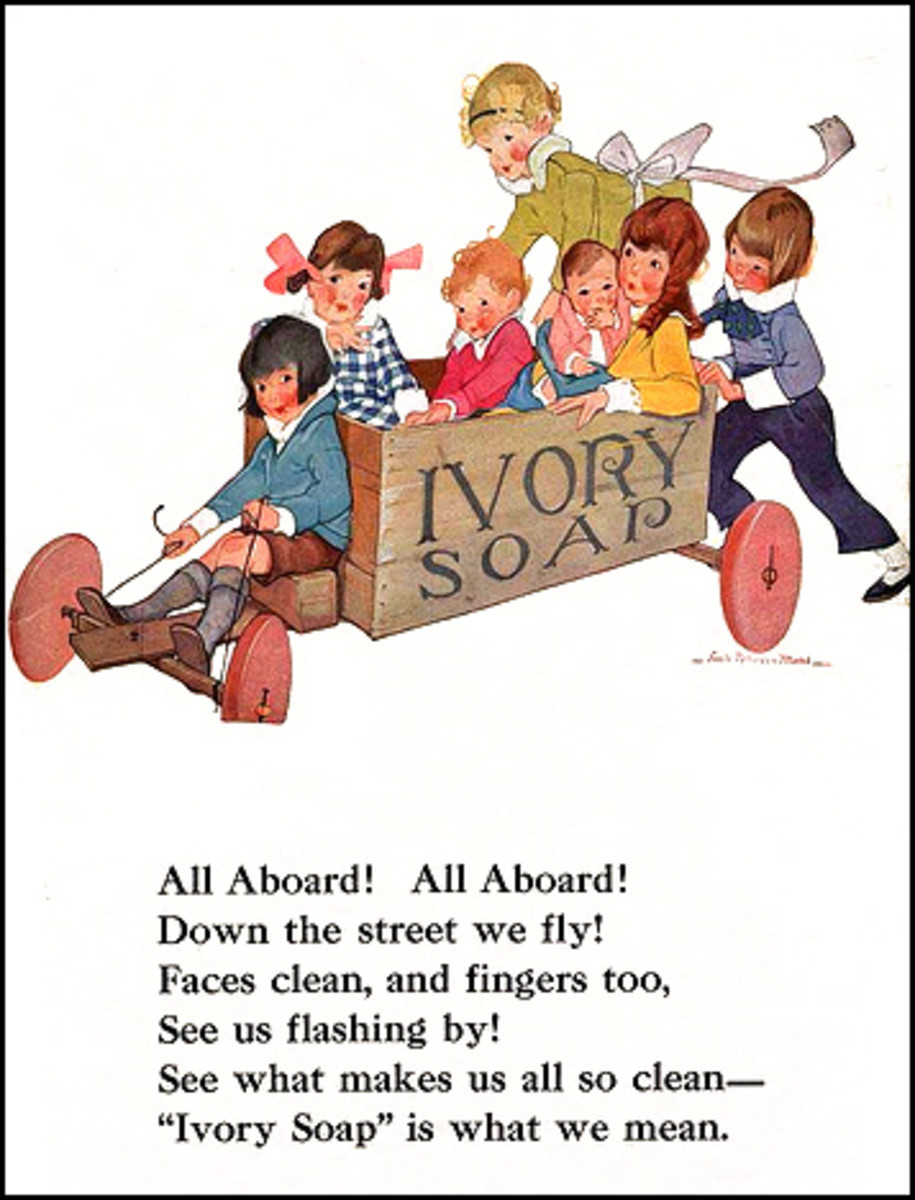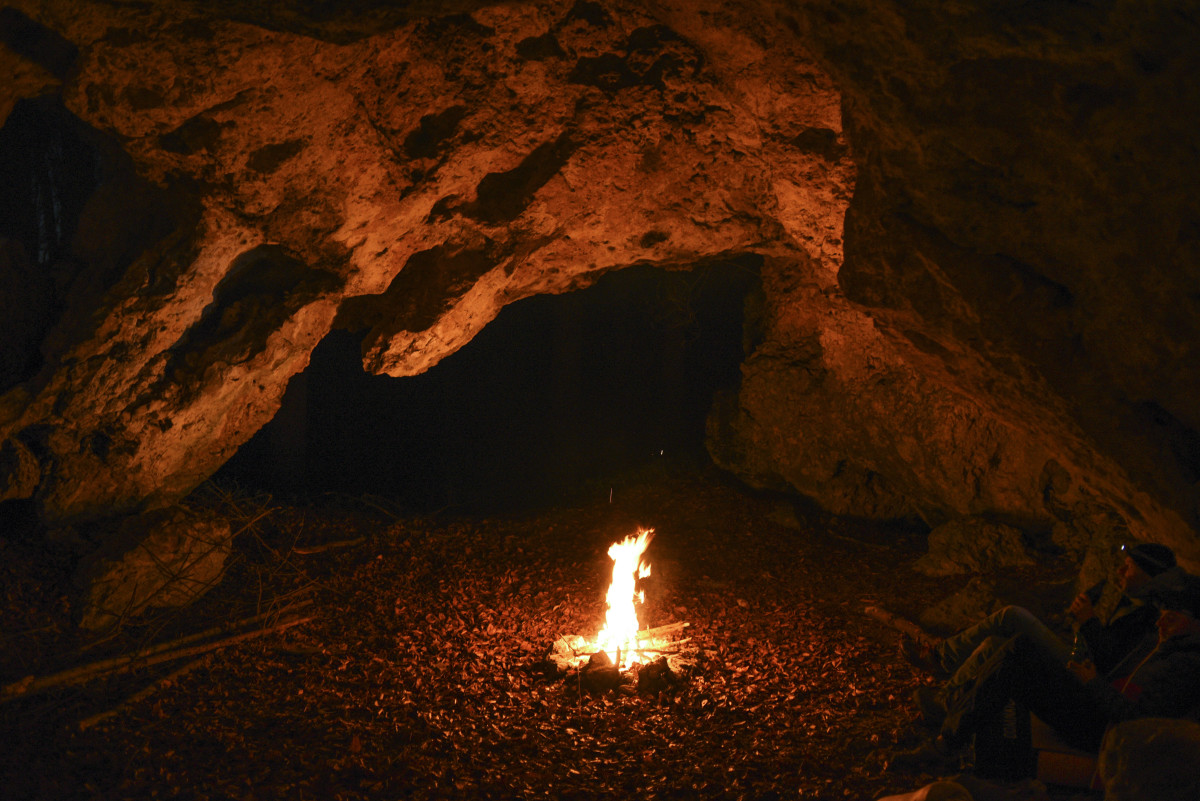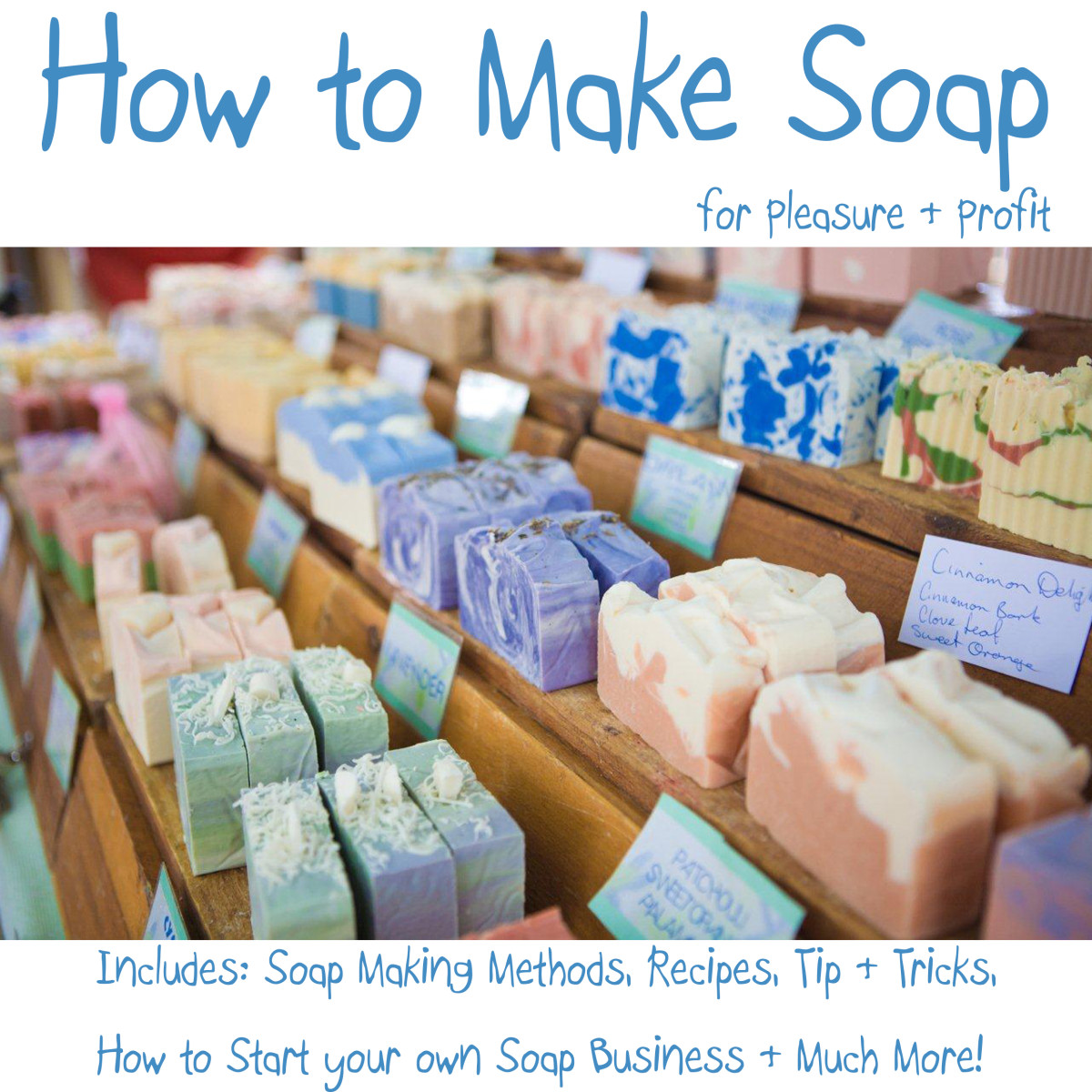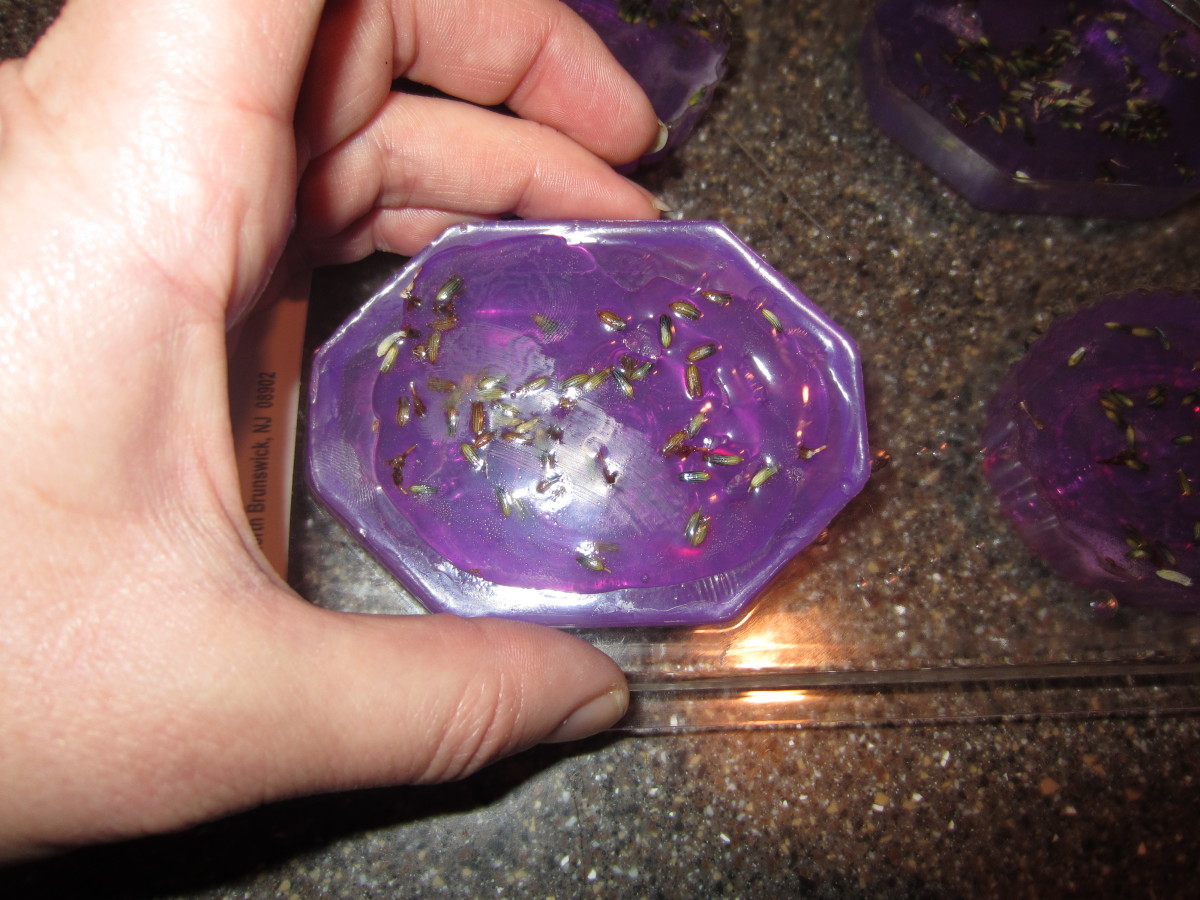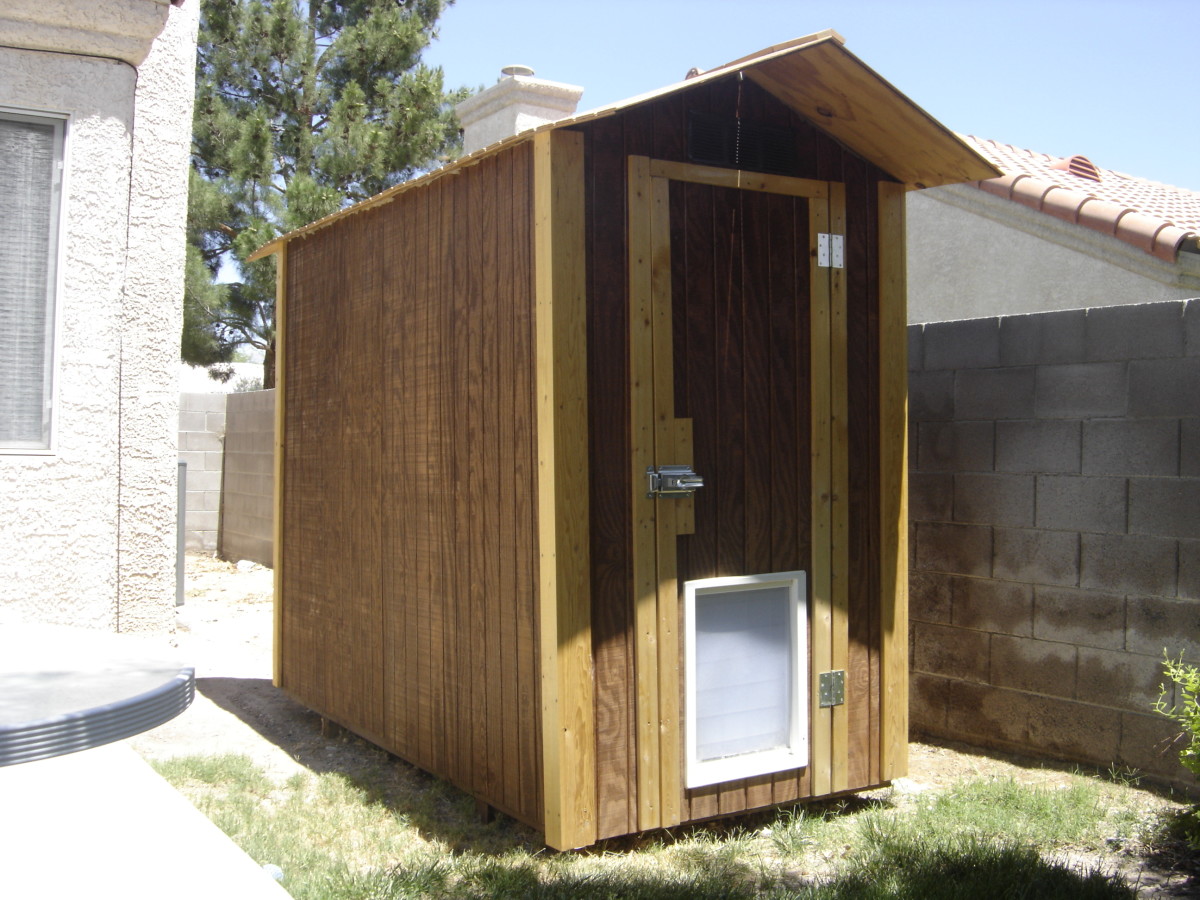All About Soap

How To Make Your Very Own Soap
A regular soap is primarily composed of soda ash (sodium), potassium (potash) salts of fatty acids derived by reacting fat with lye in a process known as saponification. That makes it a very useful agent for cleaning and rinse away the grease that adhere to human skin.

History of Soap Making
Soap making goes back to the ancient city of Pompeii, Italy about 2000 years ago. Before the advent of bath soap, people would wash with plain water, and in ancient Rome they washed with oil. The Roman's body was rubbed with oil and the person would sweat in a steam bath. The oil was then rubbed off, and the bather finished up in a pool of cool water. This Roman oil bath sounds interesting, but not very clean.
Do It Yourself Books on Soap Making
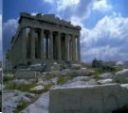
Ancient Roman Legend About Soap
A story encountered in some places claims that soap takes its name from a supposed "Mount Sapo" where ancient Romans sacrificed animals. Rain would send a mix of animal tallow and wood ash down the mountain and into the clay soil on the banks of the Tiber. Eventually, women noticed that it was easier to clean clothes with this "soap".
The location of Mount Sapo is unknown, as is the source of the "ancient Roman legend" to which this tale is typically credited. In fact, the Latin word sapo simply means "soap"; it was borrowed from a Celtic or Germanic language, and is cognate with Latin sebum, "tallow", which appears in Pliny the Elder's account. Roman animal sacrifices usually burned only the bones and inedible entrails of the sacrificed animals; edible meat and fat from the sacrifices were taken by the humans rather than the gods. Animal sacrifices in the ancient world would not have included enough fat to make much soap. The legend about Mount Sapo is probably apocryphal.

Arab History
The Arabs made soap from vegetable oil such as olive oil and some aromatic oils such as thyme oil. Lye (Al-Soda Al-Kawia) was used for the first time, and the formula hasn't changed from the current soap sold in the market.
From the beginning of the 7th century, soap was produced in Nablus (West Bank,Palestine), Kufa (Iraq) and Basra (Iraq). Soaps, as we know them today, are descendants of historical Arabian Soaps. Arabian Soap was perfumed and colored, some of the soaps were liquid and others were hard. They also had special soap for shaving. It was commercially sold for 3 Dirhams (0.3 Dinars) a piece in 981 AD. Al-Razi 's manuscript contains recipes for soap. A recently discovered manuscript from the 13th century details more recipes for soap making; e.g. take some sesame oil, a sprinkle of potash, alkali and some lime, mix them all together and boil. When cooked, they are poured into molds and left to set, leaving hard soap.
Historically, soap was made by mixing animal fats with lye. Because of the caustic lye, this was a dangerous procedure (perhaps more dangerous than any present-day home activities) which could result in serious chemical burns or even blindness. Before commercially-produced lye (sodium hydroxide) was commonplace, potash, potassium hydroxide, was produced at home for soap making from the ashes of a hardwood fire.
Castile soap was produced in Europe as early as the 16th century.
E-A-S-Y Soap Making Vids

Natural Handmade Soap Recipes!
...here are the few soap making recipes made and shared ideally for you.
Butterfly Soaps by T.J.Currey
...All the credits belong to the generous people who shared their marvelous knowledge in creating a unique soap recipes.
Materials:
One bar glycerin or lye-based soap (bar#1)
A second bar or scrap of glycerin or lye-based soap in a different color than bar#1 - big enough to use a cookie cutter with. Depth should be between 1/4 and 1/2 inch.
3 - 4 drops clear glycerin melt and pour soap
Small, metal butterfly cookie cutter
Soap paint
- Decide which bar is to be the main bar (bar #1) and which is to be used to cut out the butterfly.
- Cut out a small soap butterfly using a metal cookie cutter.
- Melt a small amount of clear glycerin melt-and-pour soap. Using a plastic dropper, drop 3-4 drops of glycerin onto bar#1 and carefully press the butterfly against the melted glycerin. Wait approx. 10 minutes for it to cool.
- Take out your soap paints and start playing. You can paint a sun, little antennae on the
butterfly, spots, grass - anything you desire. In addition, you don't have to limit yourself to just butterflies! Cut out stars, moons, flowers, etc. using the same procedure outlined in steps 2 and 3 and then paint to your heart's content.
- Let paint dry for 24 hours before wrapping.


Some Fun Facts About Soap!
- Why are soap bubbles round? We thought you'd never ask. It's because the surface tension of the bubble's water wants to contract, and the sphere is the shape that holds the most volume within the smallest surface area.
- In the 1500s, most people got married in June because they took their annual bath in May and still smelled pretty good by June (according to standards of the day). However, they were starting to smell by June, so brides carried a bouquet of flowers to hide their odor. Hence the custom today of a bride carrying a bouquet of flowers ... and also the custom today of bathing more often than once a year!
- Also back then, baths consisted of a big tub filled with hot water. The man of the house had the privilege of taking the first bath in the clean water. Then all the other men and sons would wash, then the women, and after that the children. Babies went last, and by then the water was so dirty you could actually lose one in it. Hence the saying, "Don't throw the baby out with the bath water." Hopefully this saying caught on quickly.
- Why does Ivory soap float? One day in 1875, an employee at Procter & Gamble accidentally left a soap mixer on when he went to lunch. The soap was so over-mixed that it had much more air in it and was more white than usual. The company tried selling this new product, and people loved it. The soap became very popular and has been floating ever since.
- In the 1930s, soap companies sponsored the first US radio shows about the lives of everyday people. These were 15-minute shows intended to grab the attention of the listener so they would stick around to hear the advertisements. The term "soap opera" was eventually applied to all similar dramas. And all this time you thought a soap opera involved singing the praises of good soap.
Shaving Soap
All you need to have:
2 pounds Bramble Berry Goats Milk liquid soap base
2 tbs. Calendula, ground
8 oz. melt and pour base
1 oz. of your favorite fragrance
*Add melted melt and pour to the goatsmilk base; stir in fragrance oil and ground calendula.
*Pour into wide mouth jars; wait 24 hours to harden.
*Soap will get slightly hard but not hard enough to pour into individual molds.

Chunk Soap Making Project
Photo and Recipe Shared by Fabienne Nichols.
Chunk Soaps are beautiful to behold and lots of fun to make. This is so ideal for kids to do this summer or if you want to try something new skills. I guess, this is a great idea. You'll never know you could turn it to a "big" business someday.
Here's it is...
First, use freshly made chunks, or ones that have been stored in an airtight baggie- if they're too dry, this'll cause non-sticking.
My overpour soap is --don't know the exact temp-- just "below" steaming. Opaque chunks (w/ titanium dioxide) will tend to melt "worse", so be careful, and overpour onto these at a bit lower temp. I do mostly "random" chunks, so don't worry about placement, but...
Do NOT freeze chunks. This'll get ya moisture, and, as someone points out, changes the soap somehow. If you're freezing soap to get out of the mold for bars, don't freeze all the way, just enough to do outside. Best thing is to be patient and let soap harden and shrink a bit. I'm a bit forgetful, and have left soap in overnight, yuck! So I almost never freeze.
Pour a bit of overpour in the mold (to prevent holes and bubbles on the top), grab a handful of chunks, spritz w/ rubbing alcohol, and "dump" 'em in. You'll want to spritz RIGHT before you place the chunks in, or alc will evaporate. A good spray, too, so that it looks wet all over, but don't soak. A FINE mister helps. Pour in more overpour, grab, spray, dump. Spritz what you've poured in if alcohol has evaporated when you overpour more. Pour, grab, spray, dump. Repeat. For the 32 oz delta mold, which I generally use for loaves, I pour a bit about 1/8 full, dump (after spritzing), then fill about 1/2 full, spritz, dump, spritz, dump, etc till full of chunks. This'll let you look at "design", and strategically place some if you're doing different colors, or stir them up a bit to get the look you want. Then do one more filling pour and dump. If you want the chunks all the way through, have some stick out of the "top" and trim later.
The alcohol PREVENTS the "bubble" look. It will help the overpour adhere. If you're getting any other effect from the alcohol, there's another factor involved. It's a pretty automatic, and fast thing after you do a bunch. If you start to get a skin on the overpour, spritz. If you get a skin on the over pour in the pouring pot, spritz. I do this with chunks in one hand,
alcohol spritzer in the other. Sorta plan the "design" before you go. I do a lot with marbled chunks, so don't have to worry about one color vs the other, but if I'm doing a couple different colored chunks, you may want to have one pile of "mixed" ones, but have them separate also, to fill in when the random grab doesn't appear random. You may grab a handful of mixed, but end up with most of one color...
Remember that a LOT of mp "artistry" is in color. I do opaque chunks with clear overpour, and transparent colored chunks with white overpour. Sometimes a loaf will not look "right", even though it was done correctly, it's probably in the colors, contrast, or lack thereof.
It's REALLY not as complicated as I've made it sound. Personally, though, I'd start with chunks in a smaller bar until you get the technique. That way you won't "waste" 2 lbs. You want the success with a smaller amount before going to a large loaf.
And don't throw out the "wasted messed up" loaf! Cut it up, and use some of those chunks, maybe smaller chunks, in a single bar, to get the spritzing and pouring down. Save some for shredding, and putting shreds in a loaf or bar. (ahh, THAT'S when I do freeze!, but that's another story). ---Teachsoap.com
All About Soap Poll - Share us your thoughts by just a quick poll...
Which of these soap scent is your most favorite?
Let's be organic! Let's stay natural!
Natural is still the best!



